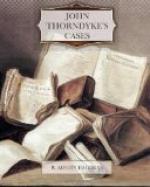“Yes,” I replied; “there is the place well in view, and you can see right up the road. I had no idea this house stood so high. From the three upper windows you can see all over the country excepting through the wood.”
“Yes,” Thorndyke rejoined, “and he has probably been in the habit of keeping watch up here with a telescope or a pair of field-glasses. Well, there is not much of interest in this room. He kept his effects in a cabin trunk which stood there under the window. He shaved this morning. He has a white beard, to judge by the stubble on the shaving-paper, and that is all. Wait, though. There is a key hanging on that nail. He must have overlooked that, for it evidently does not belong to this house. It is an ordinary town latchkey.”
He took the key down, and having laid a sheet of notepaper, from his pocket, on the dressing-table, produced a pin, with which he began carefully to probe the interior of the key-barrel. Presently there came forth, with much coaxing, a large ball of grey fluff, which Thorndyke folded up in the paper with infinite care.
“I suppose we mustn’t take away the key,” he said, “but I think we will take a wax mould of it.”
He hurried downstairs, and, unstrapping the case from his bicycle, brought it in and placed it on the table. As it was now getting dark, he detached the powerful acetylene lamp from his machine, and, having lighted it, proceeded to open the mysterious case. First he took from it a small insufflator, or powder-blower, with which he blew a cloud of light yellow powder over the table around the remains of the clock. The powder settled on the table in an even coating, but when he blew at it smartly with his breath, it cleared off, leaving, however, a number of smeary impressions which stood out in strong yellow against the black oilcloth. To one of these impressions he pointed significantly. It was the print of a child’s hand.
He next produced a small, portable microscope and some glass slides and cover-slips, and having opened the paper and tipped the ball of fluff from the key-barrel on to a slide, set to work with a pair of mounted needles to tease it out into its component parts. Then he turned the light of the lamp on to the microscope mirror and proceeded to examine the specimen.
“A curious and instructive assortment this, Jervis,” he remarked, with his eye at the microscope: “woollen fibres—no cotton or linen; he is careful of his health to have woollen pockets—and two hairs; very curious ones, too. Just look at them, and observe the root bulbs.”
I applied my eye to the microscope, and saw, among other things, two hairs—originally white, but encrusted with a black, opaque, glistening stain. The root bulbs, I noticed, were shrivelled and atrophied.
“But how on earth,” I exclaimed, “did the hairs get into his pocket?”
“I think the hairs themselves answer that question,” he replied, “when considered with the other curios. The stain is obviously lead sulphide; but what else do you see?”




